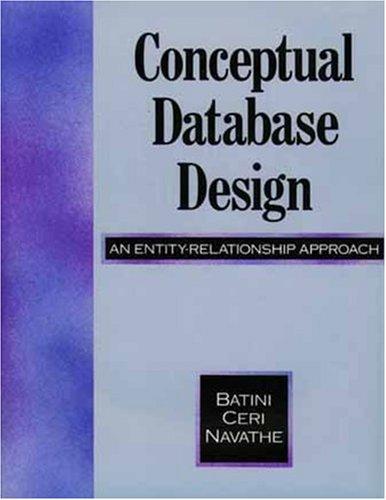Question
C++ An abstract class inherits class member property values and functions from a parent class but can have its own version(s) of member functions plus
C++
An abstract class inherits class member property values and functions from a parent class but can have its own version(s) of member functions plus its own individual class functions. The parent class may not have its own individual class members or can only serve as a base template for derived classes.
The base class, Employee, has the following class member values:
Employee ID (string such as AF201)
Hours (float)
Pay Per Hour (float)
Income Tax Rate (float such as 0.014, 0.022, 0.1)
Over time hours (float)
Employee Status (string such as Hourly, Salaried, Contractor)
Initialize (overloaded) functions for the Hourly, Salaried, Contractor
Member functions include:
SetID (pass a string to set the Employee ID for this class member)
SetHours (pass a float to set the Hours)
SetPay (pass a float to set the Pay Rate)
SetTaxRate (pass a float and set the Income Tax Rate for this class member)
SetStatus (pass a string to set the Employee Status)
getID (return Employee ID)
getHours (return Hours)
getPay (return Pay Per Hour)
getStatus (return Employee Status)
Employee Constructor (EmpID = N/A, numeric values = 0, Employee Status = N/A)
Virtual abstract function terminate
Virtual abstract function calculatepay
Virtual abstract function setovertime
Derived classes:
Hourly Class which its version of calculatepay:
Regular Pay (hours <= 40 hours) X Pay Rate
Overtime Pay (any hours > 40) X Pay Rate X 1.5
Gross Pay = Regular Pay + Overtime Pay
Taxes = Gross Pay X Tax Rate
Net Pay = Gross Taxes
Display Regular Hours, Overtime Hours (if any), Pay Rate
Display Regular Pay, Overtime Pay (if any)
Gross Pay, Taxes Withheld, Net Pay
Hourly has another function, Overtime
Determines Regular Hours and any Overtime Hours based on what the Hours were
If Hours <= 40 then Overtime Hours = 0
If Hours > 40 then Regular Hours = 40 and Overtime Hours = Hours 40
Reset Hours = 40
Salaried Class
Gross Pay = Pay Rate (represents Annual Salary)
Taxes Withheld = Gross Pay X Tax Rate
Net Pay = Gross Pay Taxes Withheld
Display Gross, Taxes and Net Pay
Contractor Class
Gross Pay = Pay Rate (represents contractor fee)
No income taxes withheld
ALL derived classes also have a terminate function
Set Hourly numeric values to 0, Keep Employee ID, set Empstatus = Hourly Terminated
Set Salaried numeric values to 0, Keep Employee ID, set Empstatus = Salaried Terminated
Set Contractor numeric values to 0, Keep Employee ID, set Empstatus = Contract Ended
Main includes:
Store class members into an array, one array for Hourly, one array for Salaried and a third array for Contractor members. Maximum of 10 class members per Employee type (i.e. up to 10 Hourly, 10 Salaried, 10 Contractors)
Allow user to:
Enter data for the Hourly (Employee ID, Total Hours Worked, Pay Rate, Income Tax Rate, Status (Hourly)
Enter data for the Salaried (Employee ID, Annual salary represented by Pay Rate, Income Tax Rate
Enter data for Contractor (Employee ID, Contractor Fee represented by Pay Rate
Set Class member Values into its array
Display the ID, Pay, Hours Tax, Net if any for Hourly
Display the ID, Annual Salary, Tax, Net for the Salaried
Display the ID, Contractor Fee for the Contractor
Terminate a derived class member Employee (Hourly, Salaried, Contractor)
Quit
Allow the user to enter as many class members up to 10 each in their individual array. Since we are using virtual functions, derived class members are accessed via pointers of type base (parent)
1 - Enter Data for Hourly Employees
2 - Enter Data for Salaried Employees
3 - Enter Data for Contractor Personnel
4 - Display Data for Hourly Employees
5 - Display Data for Salaried Employees
6 - Display Data for Contractor Personnel
7 - Terminate an Hourly Employee set Employee Status to Hourly - Terminated
8 - Terminate a Salaried Employee set Employee Status to Salaried Terminated
9 - Terminate a Contractor set Employee Status to Contract Ended
10 - Quit
Enter Option (1 - 10):
Initialize the first 3 Employee array locations for each Employee Type:
Hourly: (ID, Hours, Pay Rate, Tax rate)
ID: "AS101", Hours: 32.34, Pay Rate: $28.50, Tax Rate: 0.055
ID: "GH199", Hours: 44.5, Pay Rate: $39.22, Tax Rate: 0.04
ID: "UY189", Hours: 47.22, Pay Rate: $45.60, Tax Rate: 0.016
Salaried: (ID, Pay Rate, Tax rate)
ID: "VE320", Annual Salary: $45,750.34, Tax Rate: 0.07
ID: "BR003", Annual Salary: $65,740.88, Tax Rate: 0.065
ID: "AA891", Annual Salary: $50,900.71, Tax Rate: 0.12
Contractor: (ID, Pay Rate)
ID: "BV111", Contractor Fee: $55,473.56
ID: "NB290", Contractor Fee: $65,540.87
ID: "VC100", Contractor Fee: $45,679.25
There are two ways to hold class members in the array and access it. Which one you choose will decide the where the initialize functions are located.
An array of Hourly, an array of Salaried and an array of Contractors. Use a pointer of base class Employee to access each location of that array.
An array of base class pointers aimed at each derived class.
Hint: if you remove the virtual from the parent class and it still compiles and works.what you have is not a virtual
Step by Step Solution
There are 3 Steps involved in it
Step: 1

Get Instant Access to Expert-Tailored Solutions
See step-by-step solutions with expert insights and AI powered tools for academic success
Step: 2

Step: 3

Ace Your Homework with AI
Get the answers you need in no time with our AI-driven, step-by-step assistance
Get Started


